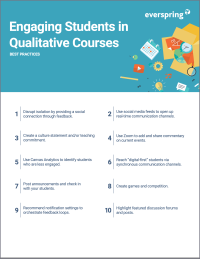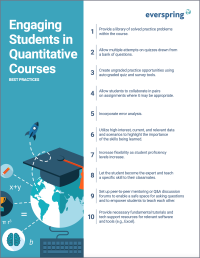Search
There are 15 results.
Tag
Tag
All (99)
Active Learning (4)
Activities (4)
Analytics (4)
Assessments (11)
Asynchrony (5)
Authentic Activities (3)
Backwards Design (2)
Canvas (8)
Case Studies (2)
Collaboration (7)
Communication (9)
Community (7)
Competency-Based Education (3)
Content Creation (13)
Copyright (1)
Course Maintenance (6)
Course Materials (4)
Course Preparation (6)
Discussions (5)
Diversity (1)
Equity (1)
Faculty Presence (8)
Faculty Support (3)
Feedback (11)
Formative Assessments (8)
Game-Based Learning (2)
Gamification (1)
Generative AI (8)
Grading (8)
Group Work (2)
Images (1)
Learning Objectives (4)
Multimodality (7)
Peer Review (1)
Presentations (1)
Qualitative courses (1)
Quantitative courses (1)
Revising (2)
Revision (1)
Rubrics (4)
Scaffolding (1)
Social Media (1)
Summative Assessments (1)
Synchrony (6)
Third-Party Tools (2)
Universal Design for Learning (UDL) (1)
Video (1)
Visual Design (1)
Workload (1)
Written Assignments (1)
Communication, Community, and Student Engagement in the Online Classroom
The most difficult task in transitioning from on-ground to online teaching is determining the best way to emulate the community and engagement inherent in a face-to-face classroom.Consider this: Your online classroom can be even more engaging than an on-campus classroom. Simple tools, such as discussion forums and announcements, can elevate your classroom immensely.
Encouraging Effective Discussions
Online forums are valuable learning tools: they merit the time and thought it takes to create them, but they must be well-designed to be effective for instructors and students. Baker and Ahlegren (2022) note that instructors may start out with the best of intentions and a desire to achieve multiple goals, such as promoting critical thinking and fostering a community of authentic learners. However, discussion boards often become just another writing assignment, a missed opportunity to “elicit debate, inspire meaningful ideas, and fully engage the learning community” (Blakely et al., 2022, para. 6). When this happens, students can view discussions as transactional, not transformative.
Updating Your Syllabus
Over time, you may want to make changes to the syllabus of a course. The syllabus documents are saved in the “Files” area (1) of the course. To preserve the integrity of the document, the Word document is located in the “Instructor Only” folder (3), and the PDF is found in the “Documents” folder (2) so it is visible to students.
Five Instructor Feedback Essentials
Providing student feedback is a key component of an instructor’s role and an important part of effective instruction. Research shows that ongoing feedback keeps students engaged and improves their morale, motivation, and learning (Best et al., 2015). Yet, providing high-quality feedback can be a time-consuming commitment, especially in courses with large class sizes or numerous written assessments. Instructors should keep in mind the tools, structure, and best practices that can help them provide feedback.
Building Your Online Course With the Lister Model
You are building a course for the online environment. What an exciting adventure! When building an online course, you might use a similar method to what you used when developing a course previously, or you might use an entirely new technique. Either option is a good option. But you may have a few questions when you first begin: How do I organize my materials? How do I display my materials? How do I make sure my students work together?
Harnessing the Third Space Theory for Effective Learning and Instructional Design Consultation
The Third Space theory, introduced by postcolonial theorist Homi K. Bhabha, explores a transformative space where new identities and meanings emerge through the interaction of diverse cultural elements. This "third space" is characterized by hybridity, challenging rigid, binary notions of identity and culture, and emphasizing fluid negotiations between dominant and marginalized perspectives (Burke, 2012; Lin, 2014). Bhabha’s theory builds on Ray Oldenburg’s (1999) concept of the "third place"—an informal public space where people gather to form a community that is neither home nor work—and extends it into the realms of cultural and social discourse, creating a broader framework for negotiating power, identity, and cultural exchange (Bhabha, 2012). These third spaces can emerge in a variety of contexts, including both physical locations like cafés or parks and virtual environments such as online forums or social media platforms, making the theory applicable to both in-person and digital interactions.










